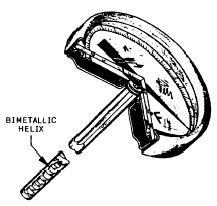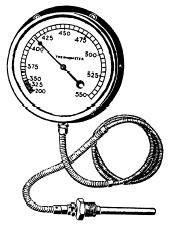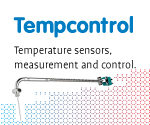Other type of thermometers used are:
- Indicator strips (moving line, Tempadot)
- Liquid expansion (Mercury thermometer, Alcohol thermometer)
- Dial thermometers (Bimetallic strip thermometer, Bourdon gauge thermometer)
- FBG temperature sensors
These sensors are mostly used for body temperature of fluid temperature measurement and are discussed in more detail in the section below.
1 Indicator strips
Moving line

Moving line temperature indicator strips (i.e. CliniTemp) can be read accurately and continuously to fractions of a degree over the entire temperature range of the thermometer with no gaps in temperature.The moving line temperature technology has also been shown to reliably reflect body temperature when placed on the foreheads of anaesthetised patients within the wide range of ambient temperatures found in the OR and Recovery.
Tempadot

A plastic strip impregnated with heat-sensitive chemical dots, which, when exposed to an increase in temperature, melt, resulting in a change of colour. They provide a faster reaction time than mercury, taking 1 minute for an oral reading and 3 minutes for an axillary reading. Tempadots are disposable and have the advantage that they reduce the risk of cross-infection.
2 Liquid expansion
Mercury thermometer

A glass bulb filled with mercury is connected to a narrow evacuated glass capillary tube. As the mercury is warmed, it expands and rises up the capillary tube into a vacuum. (Also known as a Torricellian vacuum, which is actually mercury vapour at its saturated vapour pressure). The temperature corresponds to a point on a calibrated temperature scale, measured by the height of the fluid column.
A mercury-in-glass thermometer is effective in the range -39°C to ~250°C. If a thermometer is required for lower temperatures, the alcohol-in-glass thermometer (utilising the same principle) can be used in the range -117°C to 78°C.
Advantages:
- Simple
- Cheap
- Re-usable
- No power supply needed
Disadvantages:
- Slow response time
- Easily broken
- Mercury toxicity
- Risk of cross-infection (Salmonella and Clostridium)
- Withdrawn from NHS use
Alcohol thermometer

The Alcohol thermometer or spirit thermometer is an alternative to the mercury-in-glass thermometer, and functions in a similar way. But unlike mercury-in-glass thermometer, the contents of an alcohol thermometer are less toxic and will evaporate away fairly quickly.
3 Dial thermometer
Bimetallic strip thermometer

Two dissimilar metals (different coefficients of expansion) fixed together in a coil. Differing expansion in each metal causes the coil to wind/unwind, as the temperature changes. This causes a pointer to move across a dial.
The Bimetallic strip is a mechanical temperature sensor element. It converts temperature to a mechanical displacement. This displacement may be coupled to a switch for simple on-off function, to a needle of an indicator or to a position detector for electronic output.
By far the most common application of the bimetallic strip is as a thermostat switch used for temperature and energy control.
Bourdon gauge thermometer

Patented by French watchmaker Eugène Bourdon in 1849.
This is a hollow spiral metal tube, based on the Bourdon pressure gauge. The tube terminates at one end in a temperature-sensing bulb containing a volatile liquid or vapour. This expands as the temperature rises, causing the tube to unwind, which in turn moves a pointer.
Advantages:
- Cheap
- Robust
- Easily read
Disadvantages:
- Poor accuracy
- Prone to calibration errors
4 FBG thermal sensor
A fibre brag grating (FBG) is a type of distributed Bragg reflector constructed in a short segment of optical fibre that reflects particular wavelengths of light and transmits all others. This is achieved by creating a periodic variation in the refractive index of the fiber core, which generates a wavelength specific dielectric mirror.

The expansion of the fibre causes the pattern to expand an cause a wavelength shift of the reflected light. This wavelength shift can be detected with high accuracy. This way many sensors can be made with this principle. A bare FBG is already a temperature sensor, because the thermal expansion of the glass fibre. The sensitivity of the sensor can be enhanced by coating the FBG with a higher expansion material.
